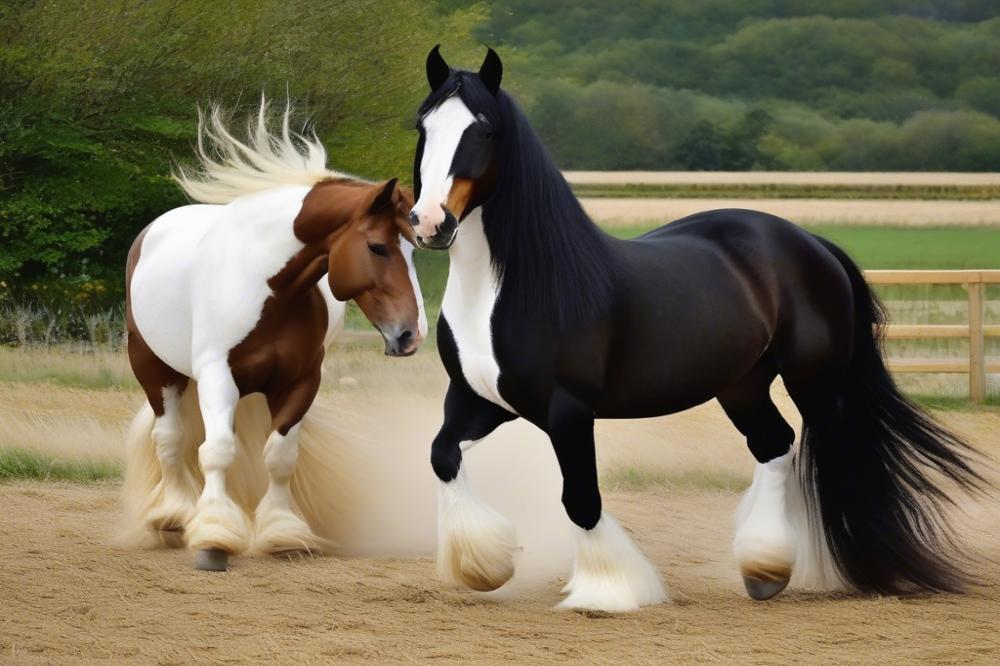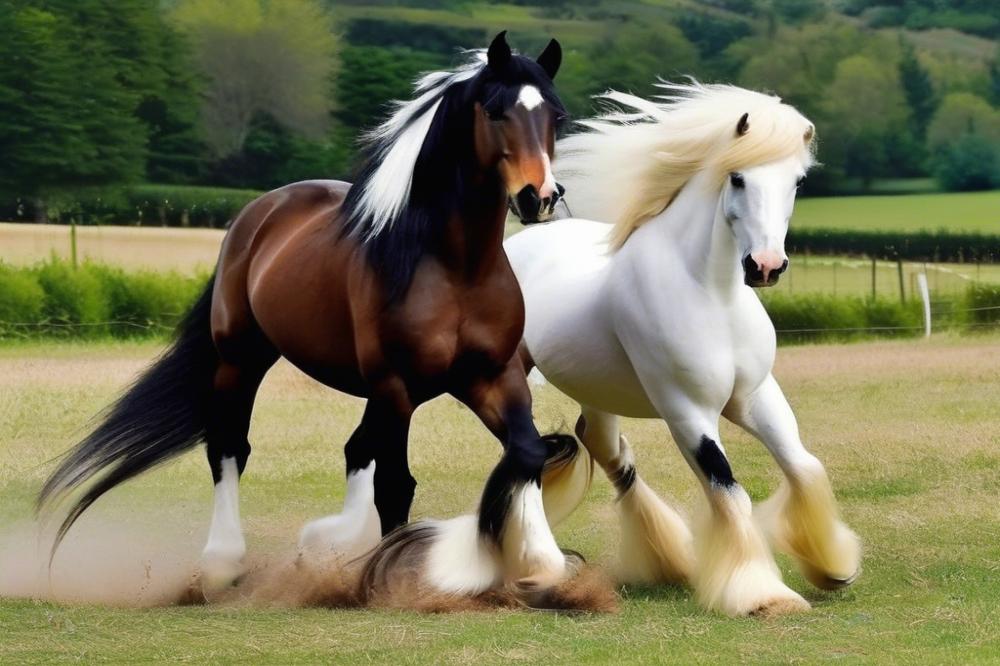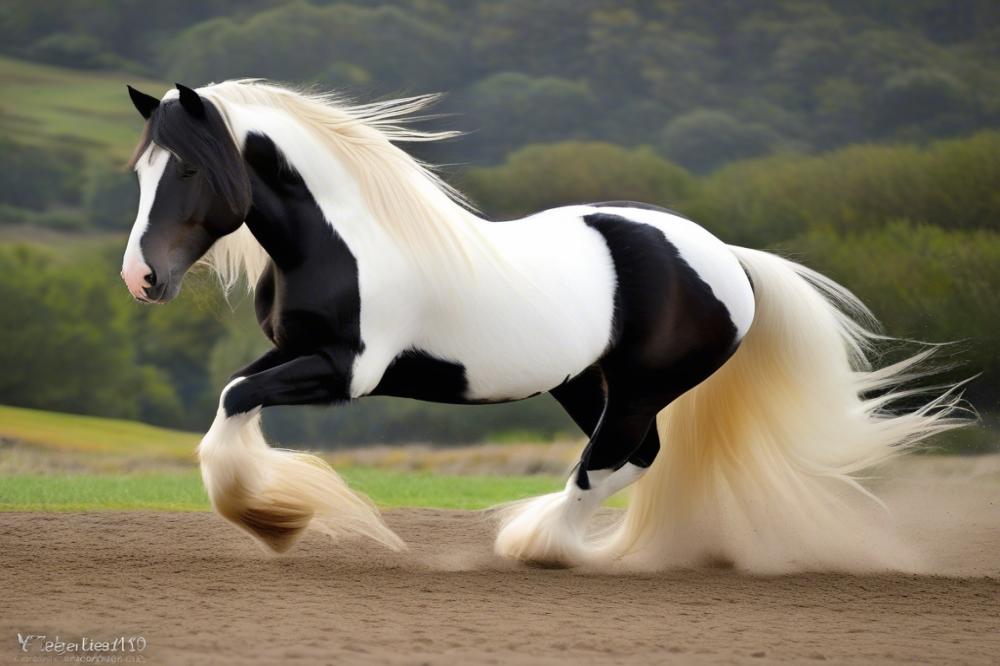A Glimpse into Gypsy Cobs and Gypsy Vanners
When it comes to adorable, stocky horses, Gypsy Cobs and Gypsy Vanners often steal the show. These breeds have a rich history, rooted deep in the nomadic culture of the Romani people, and they are beloved for their striking looks as well as their charming temperaments. With a mix of feathered hooves and flowing manes, both breeds are breathtaking sights. But how do they differ, and what can we learn about their unique equine characteristics?
Understanding the differences and similarities between these two breeds can be quite enlightening. Many folks might assume that they’re just two names for the same horse, but there are indeed distinct traits that set them apart. For instance, while both may sport some serious feathering on their legs, a keen eye can spot the subtle variations in their builds and temperaments. Knowing these nuances can help horse enthusiasts and potential owners make informed choices about horse care and training.
This article aims to shed light on the fascinating world of these two horse breeds. By bridging the gap between Gypsy Cob traits and Gypsy Vanner traits, we hope to provide a thorough horse breed comparison that informs and delights. Whether you’re a seasoned equestrian or just starting your journey, understanding these breeds can enrich your appreciation for them. Plus, who wouldn’t want to learn more about a horse that could very well be the star of their next adventure?
So grab a cup of tea, settle in, and let’s chat about these magnificent creatures. You might even find yourself pondering about the most fitting names for palomino horses male as we explore different breeds. Who knows where the conversation will lead? After all, every horse has its own story, much like the breeds of war horses that have stood the test of time!
History and Origins

To understand Gypsy horses, we must first look back to their roots. These horse breeds originated with the Romani people, also known as Gypsies. They traveled across Europe, especially the British Isles, and were known for their caravan life. With them, they brought their horses. These horses were vital for pulling their caravans and living their nomadic lifestyle.
Over time, two distinct types of horses emerged from this history: the Gypsy Cob and the Gypsy Vanner. The Gypsy Cob was more rugged and strong, bred primarily for utility and hard work. In contrast, the Gypsy Vanner gained attention for its beauty and grace. People admired the Vanner for its flowing mane and feathered legs. So, while they share a common ancestry, their development differs significantly.
Cultural significance plays a big role in these equine characteristics. For the Romani, horses symbolize freedom and pride. Caring for a horse is more than just a task; it’s a cherished relationship. Many Romani families view their horses as part of the family. This bond influences the horse care practices that are often passed down from generation to generation.
Each breed showcases unique traits that fit their historical needs. The Gypsy Cob traits often include a stocky build and a calm temperament. On the flip side, Gypsy Vanner traits highlight elegance and a gentle nature. This horse breed comparison reveals not only how the horses look but also how they interact with humans.
Stories abound in the Romani communities about these magnificent animals. One might hear tales of a brave horse carrying its rider through tough terrains or a family gathering around a beautiful Vanner at sunset. These memories add layers to the horses’ identities and deepen their cultural roots.
Physical Characteristics

Size and Build Comparisons
When comparing these two horse breeds, size is important. Gypsy Cobs are generally a bit stockier and heavier. Think of them as the bodybuilders of the horse world. On the other hand, Gypsy Vanners tend to be a little taller and more elegant. While both have a strong build, the Cob usually has a more compact frame. Vanners showcase a lovely grace, making them look more like dancers. Builders often aim for a horse that can carry weight well. Cobs excel at pulling heavy loads, thanks to their sturdy legs.
Coat Colors and Patterns
Both breeds display a wide range of coat colors and patterns. Gypsy Cobs frequently have a rich blend of deep browns, black, and whites. Spot patterns can create stunning visuals. You might see a Cob adorned with patches that resemble a painter’s canvas! Gypsy Vanners, however, emphasize beauty and style with their shiny coats. They often display more variations, such as the striking piebald or skewbald patterns. The way the colors blend gives them an air of mystery, making people do a double take.
Mane and Feathering Differences
Mane styles also vary, playing into their distinctiveness. The Gypsy Cob’s mane tends to be thick and flowing, often cascading down as if it’s been brushed by the wind. You may find it appears a tad unkempt, giving off a fun, wild vibe. Conversely, the Vanner’s mane leans toward polished elegance. It flows smoothly, almost like it’s been styled for a special event. Feathering around the legs creates another difference. Both breeds boast impressive feathering, but the Gypsy Cob usually has denser and more pronounced feathering. This extra fluff can look almost like furry booties! Gypsy Vanners sport feathers that are elegant, maintaining a sleek profile.
Every detail showcases the special traits of these two breeds. Adult horses of both types will charm you the moment you lay eyes on them!
Temperament and Behavior

When comparing these horse breeds, one can’t ignore their temperament. Gypsy Cobs are known for being gentle giants. They often display a calm demeanor, which makes them great companions. On the other hand, Gypsy Vanners tend to have a more spirited personality. While they’re still friendly, they can be a bit more energetic and playful. Both breeds have a knack for forming strong bonds with their handlers.
Energy levels can vary quite a bit. Gypsy Cobs tend to have a more laid-back attitude. They enjoy leisurely activities and can be perfect for relaxed trail rides. Gypsy Vanners, though, might be a little more lively. They often have bursts of energy, which can make them exciting to ride. However, this added zest can also mean they require more engaging activities.
Trainability is another factor to think about. Both breeds generally learn well, but the approach may differ slightly. Gypsy Cobs often respond to gentle cues and patience. These traits make them suitable for novice riders. On the flip side, Gypsy Vanners, with their spirited nature, might thrive better with riders who have a bit of experience. They need consistent training and can be more challenging if not properly handled.
As for suitability, it all depends on the rider’s experience. New horse owners might find Gypsy Cobs to be the best fit. Their calm and steady personality makes them less intimidating. More seasoned riders may enjoy the challenge offered by Gypsy Vanners. These spirited equines can bring excitement to any riding session.
With all these equine characteristics in mind, it’s clear that each breed has its own strengths. Some owners prefer the gentle approach of a Gypsy Cob. Others might appreciate the lively energy of a Gypsy Vanner. Whichever you choose, both breeds can bring joy and companionship to your life.
Uses and Versatility
Common Uses for Gypsy Cobs
Gypsy Cobs are like trusty sidekicks to many horse lovers. They offer a strong, steady presence and are ideal for various tasks. All kinds of riders enjoy their gentle nature and solid build. Many folks use them for leisure riding on nature trails; their sure-footedness shines here. Some take these horse breeds into the show ring, showcasing their beauty and charm. Even in driving, they excel, pulling carts with grace and power. Owners often highlight their calm demeanor, making them popular for families and beginners.
Popular Roles for Gypsy Vanners
On the other hand, you might find a Gypsy Vanner strutting their stuff in a different light. Their striking looks often catch the eye at shows. Their feathers and flowing manes seem like fairy tales come alive. Many riders opt for them in dressage and jumping. Skillful trainers appreciate their agility and intelligence. They’re often chosen for various performance events, thanks to their natural enthusiasm and willingness to learn. Vanners can also make excellent therapy horses, soothing those in need with their gentle nature.
Comparison in Adaptability Across Disciplines
Both breeds demonstrate impressive adaptability, but they shine in different areas. Gypsy Cobs bring a strong work ethic, fitting well into roles needing strength and reliability. Their sturdy build supports many tasks, from farming to festive parades. Vanners, however, often dazzle in athletic competitions. Their agility lends itself to jumping and dressage, making them a favorite among competitive riders.
Each breed displays separate equine characteristics that cater to diverse riding disciplines. A horse breed comparison shows us that Gypsy Cobs may be the best for leisurely work, while Vanners often dazzle in competitive environments. Care for either horse breeds emphasizes proper nutrition and exercise to maintain their health and performance. Different talents, yet both endear themselves to horse lovers around the globe.
Care and Maintenance
Grooming Needs Specific to Each Breed
Grooming is a big part of horse care, especially for these breeds. The Gypsy Cob has a lot of thick, flowing hair. Regular brushing helps keep their coats shiny and free of debris. You might need to invest in quality brushes. A good curry comb can work wonders on their luxurious coats. Meanwhile, the Gypsy Vanner also has a beautiful mane and tail. Keeping these tangle-free is key. Daily grooming will help avoid knots and show off their lovely features. It’s not just about looks; it strengthens your bond with your horse, too!
Feeding and Nutritional Requirements
Feeding these horse breeds can be quite different. Gypsy Cobs tend to be stocky and strong, which means they require a good mix of hay and grains. Their diet helps support their powerful build and activity level. On the flip side, Gypsy Vanners, known for their graceful movement, also need quality hay but might benefit from lower starch grains. Horse care often includes supplements for shiny coats and overall health. Always remember to provide fresh water—keeping them hydrated is critical, no matter the breed.
Common Health Concerns and Care Practices
Just like people, horses can have their share of health issues. Gypsy Cobs may face weight management challenges. Their hearty appetite can lead to obesity if you’re not careful. On the other hand, Gypsy Vanners can be more prone to skin problems due to their feathers. Regularly checking their legs is a smart practice. Keep an eye out for rain rot or infections. Routine veterinary care is important for both breeds. Vaccinations, deworming, and dental checks are all part of horse breed comparison in care practices. Associating good health with regular maintenance keeps them happy and can make owning a horse a real pleasure.
Cultural Impact and Popularity
Today, both horse breeds have gained a lot of fans, reaching far and wide beyond their origins. In recent years, they’ve shown up in parades, festivals, and even television shows. Their striking looks and lively personalities make them favorites among horse lovers everywhere. Everyone seems to love sharing videos of their beautiful gaits and flowing manes on social media. It’s always a thrill to see them dance through competitions and shows!
Within equestrian communities, these breeds serve important roles. They participate in various events, from traditional shows to modern riding competitions. Many folks appreciate their versatility, often used in disciplines like dressage and trail riding. Passionate horse owners often find themselves bonding over tales of their beloved Gypsy Cobs or Vanners. It’s not uncommon to hear a tale about a daring ride or an amusing horse mishap that will make everyone laugh.
Horse enthusiasts have flocked to these breeds not only for their looks but also for their charming temperaments. Owners often highlight traits of strong loyalty, making them cherished companions. When discussing horse care, it’s crucial to mention their unique needs. Grooming those long manes can be a labor of love. In moments of bonding during grooming, friendships blossom among riders, which strengthens the equestrian community.
Breed organizations play a significant role in promoting these fantastic creatures. They offer resources for education and resources to keep people informed about the advantages and care involved in ownership. Horse breed comparison articles and events help potential owners make informed decisions. In gatherings, from fairs to local competitions, the camaraderie between owners and fans creates an exciting atmosphere.
Whether it’s a friendly competition or just sharing stories, the Gypsy Cob and Gypsy Vanner have certainly made an impact. They capture the hearts of riders everywhere. Their vibrant presence in the horse world is a testament to their charm and appeal. Plus, who doesn’t love a fluffy friend with style? These horses truly bring joy and excitement wherever they go!
Wrapping It Up
Throughout our exploration of the Gypsy Cob and the Gypsy Vanner, we’ve uncovered some fascinating differences and similarities between these two breeds. Both possess a rich history that stems from their connection to the Romani culture, which adds a layer of charm to their already stunning appearances. Their feathered legs, kind disposition, and versatility make either choice an appealing one for horse lovers. They truly are magnificent creatures!
So, what’s the final verdict? It really comes down to what fits in your heart and lifestyle. The Gypsy Cob, with its sturdy build and adaptable nature, is like that reliable friend who’s always up for an adventure. Meanwhile, the Gypsy Vanner, known for its striking looks and elegant movements, might just steal your heart the moment you see it prancing around. Whether you’re looking for a gentle companion for leisurely rides or a flashy show stopper, both breeds have something special to offer.
Before you dive headfirst into choosing your new equine partner, it’s crucial to consider the characteristics of these breeds. Think about your own experience with horses, the type of activities you plan to pursue, and even where you’ll keep your horse herd. How much space do you have? Are you ready for the daily grooming that their luxurious coats require? These questions will help guide you toward the right decision.
For those who are considering adding a horse to their family, checking out draftsforsale.com recent additions is a great starting point. In the end, finding the perfect horse is about matching with the right personality—think of it like finding a best friend! So saddle up, do a little research, and let your heart lead the way.



